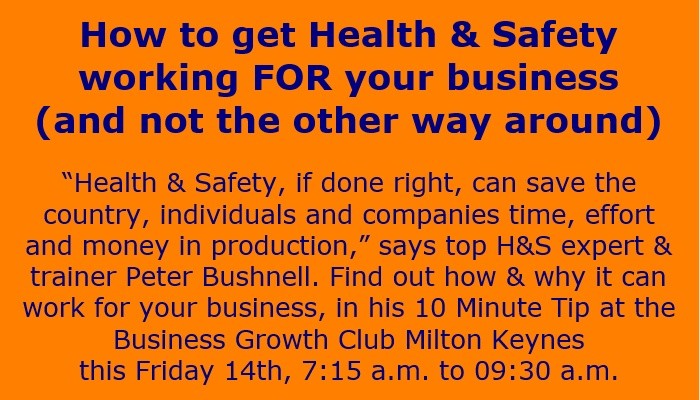'10 Minute Tip' by Peter Bushnell
Peter Has been in the food industry since he was 12 years old, starting at the locale butchers shop. There has been a lot of changes as in the meat and food interest Since Butchery Improver at 13 years’ old 2 days a week from school Shop Butcher & Window cutter Pig/Cattle Farm Hand Speed Boner/Piece Work Slaughter-House Operative New Product Development Meat Retail butchery Manager Food Service Chef Steak Counsellor Writing specification and cutting guides F/S Spot Meat Buying
At 40 he went in to H&S by accident
H&S Food Service Meat cutting/distributing sites all over Uk
H&S full BRC food proceeding sites
H&S BRC High/Low Care 3,500 staff 4 sites BulRushess Ltd Looks at H&S in a very practical way.
Peter has all way felt that the staff should understand the trading not just attend!
The individual should understand all the training undertaken.
This will lead to better staff compliance.
About the conversation:
How Health & Safety can help society, public, individuals & work places get on with ‘IT’. WHATEVER ‘IT’ IS economically.
it’s about knowing when health and safety matters are important and when they are just a guide line; not putting matters out of the way just because it’s easier to say ‘no’.
It is about giving managers solutions at the place they have the issue (i.e. on the production floor),not sitting in an office quoting law or dropping hypothetical problems on them and walking away.
Health and Safety can, if done right, save the country, individual and/or companies’ time, effort and money in production.
By helping and showing where the issues are and explaining the ‘true’ effect these issues will have to help the staff and business by not quoting legalese.
Then giving no more than 5 things for the manager to do, as long lists intimidate people and never get done.
By helping managers understand the behaviours of their staff, health & safety can be extremely cost effective; not only decreasing accidents, but improving productivity, because staff aren’t continuously leaving the shop floor to get first aid for silly incidents.
You just need to understand Health & Safety.
There are many reasons why people do health and safety, legal requirements, economic (i.e. not being fined or having claims made against you) and moral ground.
However if your health and safety is done in a practical way, where the whole corporate body understands, it covers all of these issues.
Why Language Neutral Design Training is so important
“Pictorial training is quicker and more efficient than text-based methods,” says Peter Bushnell. “Our company, BulRushess Ltd.uses diagrams and pictures to teach staff at manufacturing plants about technical aspects such as health & safety and hygiene.”
“’Language-neutral’ methods suit multi-lingual groups and those for whom a more text-based training style is less effective. Courses convey major lessons more quickly than more literal approaches and are therefore more efficient.
“In addition, we tailor modules to individual plants, because terminology for machinery differs from factory to factory, presenting problems for standardised written tests. Everything we do is bespoke. Employees see pictures of what they are working on.”
“For task-based work, pictorial training is quicker and cheaper. We have saved one company £2,000 worth of production costs a day by teaching them how to make their clean-down process more understandable and efficient.”
“What I and my company are very good at is taking a complicated system and making it very simple, so it can be understood very quickly. When people go through a task in broken-down sections they can understand how it works.”
“Our induction takes 30 minutes, with a five-minute assessment at the end that is documented proof a person understands what you have just told them. That puts the person on the shop floor food safe, technically safe and health and safety safe.”
As a trainer, Peter Bushnell holds a qualified diploma from the National Examination Board in Occupational Safety & Health (NEBOSH) and is a member of the Institute of Occupational Safety & Health (IOSH).
Credit: With grateful thanks to Rod Addy of Meat Trades Journal, from whose article some of this information has been gathered.



